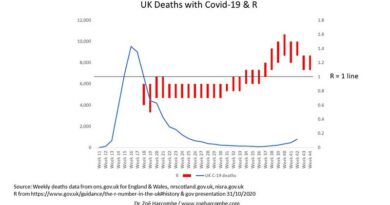Low, moderate or high carbohydrate?
In 1977 the Senator McGovern committee issued some dietary goals for Americans (Ref 1). The first goal was “Increase carbohydrate consumption to account for 55 to 60 percent of the energy (caloric) intake.” This recommendation did not come from any evidence related to carbohydrate. It was the inevitable consequence of setting a dietary fat guideline of 30% with protein being fairly constant at 15%.
Call me suspicious, but when a paper published 40 years later, in August 2018, concluded that the optimal intake of carbohydrate is 50-55%, I smelled a rat. The study, published in The Lancet Public Health (Ref 2), also directly contradicted the PURE study, which was published in The Lancet, in August 2017 (Ref 3). No wonder people are confused.
The study
The study was in three parts, but all were based on population studies and so the usual limitations of these apply. The first part was a study of 15,428 adults aged 45-64 years, in four US communities, who completed a dietary questionnaire at enrolment into the Atherosclerosis Risk in Communities (ARIC) study (between 1987 and 1989). The primary outcome of interest was all-cause mortality. The second part of the study involved combining the data from the ARIC study with data from seven (multi)national population studies in a meta-analysis. The final part was an assessment of whether the substitution of animal or plant sources of fat and protein for carbohydrate affected mortality.
I will do a complete review of all parts of the study, but I wanted to break away from looking at tomorrow’s post on keto mice and diabetes (Ref 4) to highlight what I think is the major flaw in this ‘moderate carb is best’ paper. The paper has generated irresponsible global headlines, such as “Low carb diets could shorten life, study suggests” (Ref 5). As epidemics of obesity and type 2 diabetes show no sign of abating, encouraging the consumption of at least half one’s diet in the form of the one non-essential macronutrient, is unhelpful, to say the least.
The conclusion from the first part of the paper (the ARIC study) was that 50-55% of energy from carbohydrate was associated with the lowest risk of mortality. The average intake of carbohydrate in the ARIC study was 49%. The paper presented a U-Shaped curve to indicate that carbohydrate intake below 30% and above 65% was associated with the highest risk of mortality.
I wondered what kind of person would be consuming a low carbohydrate diet in the late 1980s/early 1990s (when the 2 questionnaires in a 25 year study were done). The characteristics table in the paper tells us exactly what kind of person was in the lowest carbohydrate group. They were far more likely to be: male; diabetic; and current smokers; and far less likely to be in the highest exercise category. The ARIC study would adjust for these characteristics, but, as I often say, you can’t adjust for a whole type of person.
The Appendix to the paper revealed the biggest limitation of the ARIC part of the study: The characteristics table in the main paper split the 15,428 people into equal groups (of 3,085-3,086) from the lowest to the highest carb intake. This is the objective way to review data, because there is no argument that you drew the line in a particular place to bias the finding. The appendix revealed what had been done to produce the U-shaped finding that grabbed the headlines:
The table below shows: the carb ranges subjectively selected by the researchers; the number of people that ended up in each range; and the deaths that occurred in that carb range during the 25 year follow-up. I have then calculated the death rate (before any adjustment).
| Carb range | <30% | 30-40% | 40-50% | 50-55% | 55-65% | >65% |
| People | 315 | 2,242 | 6,097 | 3,026 | 3,034 | 714 |
| Deaths | 163 | 986 | 2,533 | 1,162 | 1,150 | 289 |
| Death rate | 51.7% | 44.0% | 41.5% | 38.4% | 37.9% | 40.5% |
The groups have been subjectively chosen – not even the carb ranges are even. Most covered a 10% range (e.g. 40-50%), but the range chosen for the ‘optimal’ group (50-55%) was just 5% wide. This placed as many as 6,097 people in one group and as few as 315 in another.
This is the single biggest issue behind the headlines.
The subjective group divisions introduced what I call “the small comparator group issue.” This came up in the recent whole grains review (Ref 6). I’ll repeat the explanation here, and build on it, as it’s crucial to understanding this paper.
If 20 children go skiing – 2 of them with autism – and 2 children die in an avalanche – 1 with autism and 1 without – the death rate for the non-autistic children is 1 in 18 (5.5%) and the death rate for the autistic children is 1 in 2 (50%). Can you see how bad (or good?) you can make things look with a small comparator group?
From subjective grouping to life expectancy headlines
For the media headlines “Low carb diets could shorten life, study suggests” (Ref 5), the researchers applied a statistical technique (called Kaplan-Meier estimates) to the ARIC data. This is entirely a statistical exercise – we don’t know when people will die. We just know how many have died so far.
This exercise resulted in the claim “we estimated that a 50-year-old participant with intake of less than 30% of energy from carbohydrate would have a projected life expectancy of 29·1 years, compared with 33·1 years for a participant who consumed 50–55% of energy from carbohydrate… Similarly, we estimated that a 50-year-old participant with high carbohydrate intake (>65% of energy from carbohydrate) would have a projected life expectancy of 32·0 years, compared with 33·1 years for a participant who consumed 50–55% of energy from carbohydrate.”
Do you see how both of these claims have used the small comparator group extremes (<30% and >65%) to make the reference group look better?
Back to the children skiing… If we were to use the data we have so far (50% of autistic children died and 5.5% of non-autistic children died) and to extrapolate this out to predict survival, life expectancy for the autistic children would look catastrophic. This is exactly what has happened with the small groups – <30% carb and >65% carb – in this study.
The data have been manipulated.
Ref 1: Carter J.P. Eating in America; Dietary Goals for the United States; Report of the Select Committee on Nutrition and Human Needs US Senate. Cambridge, MA, USA: MIT Press 1977.
Ref 2: Seidelmann SB, Claggett B, Cheng S, et al. Dietary carbohydrate intake and mortality: a prospective cohort study and meta-analysis. The Lancet Public Health 2018. https://www.thelancet.com/journals/lanpub/article/PIIS2468-2667(18)30135-X/fulltext
Ref 3: Dehghan M, Mente A, Zhang X, et al. Associations of fats and carbohydrate intake with cardiovascular disease and mortality in 18 countries from five continents (PURE): a prospective cohort study. The Lancet 2017 doi: 10.1016/S0140-6736(17)32252-3
Ref 4: https://news.sky.com/story/keto-diets-could-increase-diabetes-risk-11465771
Ref 5: https://www.bbc.co.uk/news/health-45195474
Ref 6: https://www.zoeharcombe.com/2018/08/whole-grains-cvd-cancer-mortality/





Your article was shared with me after my devoutly vegan cousin posted the article about low carbohydrates lowering life expectancy. Your analysis is brilliant and I greatly appreciate every point you address.
I am living proof that following a keto diet can improve one’s health. I’ve reversed my type 2 diabetes (a1c is now 5.2!), and all my other blood tests are in the normal ranges.
My cousin is a type 1, and controls his health issues with his vegan diet. To each their own.
Again… Thank you for your analysis.
Thanks Anne!
Hi Zoe
the usefulness of Christmas and you publishing a list of your weekly thoughts is highlighted for me by the fact that I took the time to think about what this article, and the february one on butter actually mean to me. Being lazy, I had tended to think oh carbs thats bread and sugar, but I now realise that the term includes vegetables. In the butter article you talk about diets of 80% fats, and since 15% is protein that only leaves 5% for veggies. I personally doubt my own ability to eat that much fat, and surely, vegetables have merits as well as being carbs?
whats a guy to do, eat about 35% veggies, hardly any bread or biscuits etc, is this good or bad?
Hi Chris
I don’t recommend that people follow macro nutrient ratios. I recommend that people 1) eat real food 2) choose that real food for the nutrients it provides and then they will naturally favour meat (especially red), fish (especially oily), eggs, dairy, non-starchy vegetables. I don’t think there’s anything wrong with non-diabetics enjoying oats/brown rice/quinoa/pulses and legumes – and these foods do contain valuable nutrients – just not as many as the other foods and so they shouldn’t form the basis of our diets.
I couldn’t eat that much fat either and I don’t need to. The rationale for so much fat is simply because it’s the inevitable consequence of cutting carbs drastically. Protein is in everything and so the macro nutrients that most interchange are fats and carbs. Cut one to 5-15% and the other has to go high. It just does!
This may help: https://www.zoeharcombe.com/2017/04/the-optimal-diet/
Best wishes – Zoe
Thank you. It is a confusing world.
Love to know how many in the low-carb category died in skiing accidents!
One thing I think a lot of these studies do to mislead is the following: “The final part was an assessment of whether the substitution of animal or plant sources of fat and protein for carbohydrate affected mortality.” This isn’t “substitution” of any sort. Substitution to me means you get two groups of people, one you let them eat whatever they want and for the second group, you reduce animal fat/protein and increase plant fat/protein. But that’s not what they did here. Instead, they’re comparing a group of people who happen to eat more animal fat/protein with a different group of people who happen to eat more plant fat/protein. Then they theorize that if the people who ate more animal fat/protein were to eat the same way the second group of people did, with less animal fat/protein and more plant fat protein, there would be some benefit. But it’s not “substitution” of any sort, because that never actually happened. It’s totally theoretical. But people will buy into this, and do buy into it all the time, thinking it to be correct.
Hi Bob
I completely agree – George Henderson first made me aware of this point when we were working on the UK SACN sat fat report together. They argue that epidemiological studies show that swapping sat fat out and polyunsat fat in showed X. As George kept saying every time he saw that claim “no one swapped anything!” Some people in a food frequency questionnaire ate less sat fat and some ate more sat fat – you cannot say one person did both!
Great to see he’s not the only one to keep this front of mind!
Best wishes – Zoe
I wonder if you intend to write a letter to the editor and give the authors a chance to respond.
Hi Amir
I know someone else doing a response for a US publication, so I’m happy to help that person.
Best wishes – Zoe
The supplementary data is interesting and shows, as expected, higher mortality with high glycemic load and lower fiber intake. Associations which have been demonstrated in multiple studies and have plausible mechanisms.
Looks like they have a treasure trove of data that could be analyzed in all sorts of different ways.
https://www.thelancet.com/cms/10.1016/S2468-2667(18)30135-X/attachment/4d0505ba-52b5-49ab-b803-7d456ff8815d/mmc1.pdf
So much junk science to refute, so little time. Thanks Zoe.
This is really helpful thank you. I have massively improved my health and weight (5stone down) and health markers by reducing carb consumption but I like reading researching things thoroughly and so am cynical about headlineslike these. Friends of mine who are desperate to lose weight are less interested in the science and political side of nutrition and take these headlines at face value. I fear much harm has been done by this particular news story. But this at least arms me with something to talk to them about, so thanks!
DITTO. This is helpful. I came straight to Zoe to get armed. Thanks, Ms. Harcombe!
Joyce DeWeese
Zeeland, Michigan
More generally, group statistics always hides information. If they showed all the individual data, we could see what the variability is. Of course, as you say, once you break things up into smaller, uneven divisions, everything is suspicious. But, let me not digress, Zoë. For my own study, how many slices of bread idd you have in the past 6 years?
Yup. If you look at their data, for the ‘low carb’ group, where there are only 300 or so folks, once they normalize for diabetes, cigarettes, then this small number becomes very small. What happens to their mortality rate prediction? It becomes useless and 95% confidence the number is between 1.1 and 1.6, which is no prediction at all. What to do to screw the public and twist the result. Plot the center of that number, 1.35 and say AHA!…but in reality their own model shows that their results are worthless.